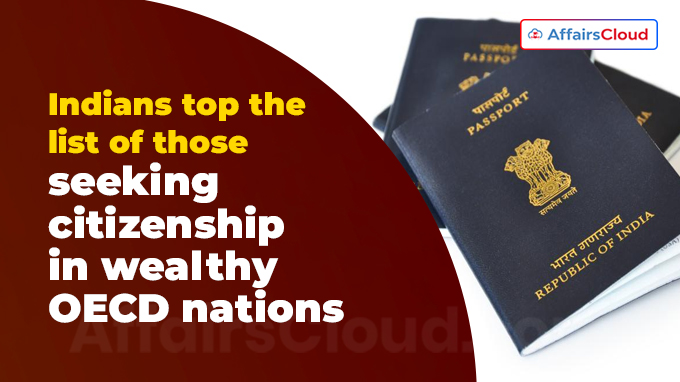 According to the “International Migration Outlook: 2023” published by the Organisation for Economic Co-operation and Development (OECD), for the 2nd consecutive year, India has retained its position as the top country of origin for new migrants to the member countries of OECD in 2021.
According to the “International Migration Outlook: 2023” published by the Organisation for Economic Co-operation and Development (OECD), for the 2nd consecutive year, India has retained its position as the top country of origin for new migrants to the member countries of OECD in 2021.
- More than 407,000 people (excluding students) have migrated from India to OECD countries in 2021. This accounts to around 7.5% of the total migration flow. This was 86% higher than 220,000 Indians in 2020.
- China is ranked 2nd with 227,000 new migrants followed by Romania (215,000); Ukraine (189,000); and Germany(119,000).
Note: OECD is a group of 38 countries, most of which are high-income and ranked very high on the Human Development Index (HDI).
International Migration Outlook 2023:
i.The 2023 report constitutes the 47th report of the OECD’s Continuous Reporting System on Migration.
- The 2023 edition analyses the recent developments in migration movements and the labour market inclusion of immigrants in OECD countries.
ii.This also monitors recent policy shifts in migration governance and integration in OECD countries.
iii.This edition features special chapters on the labour market integration of migrant mothers and fertility patterns among migrant populations in OECD countries.
Migration Flows to OECD Countries:
i.The report shows that OECD countries witnessed a remarkable 26% rise in permanent migration, reaching 6.1 million in 2022, the highest since 2005.
- Notably, 15 out of 38 OECD countries recorded their highest levels of permanent migration in 15 years, owing partly to rising labour migration addressing skill shortages.
ii.The OECD saw a remarkable rise in asylum applications, over 2 million in 2022, nearly doubling the 2021 figures and exceeding the previous record of 1.7 million in 2015.
- This was largely driven by increased applications in the United States of America (USA) and Europe.
iii.The aftermath of Russia’s aggression against Ukraine resulted in millions of Ukrainian refugees in OECD countries.
- Germany and Poland accommodated the most significant numbers.
- While Estonia, the Czech Republic, and Lithuania housed the highest proportions relative to their populations.
Labour Market Outcomes for Migrants:
i.The OECD witnessed a substantial rise in migrant employment in 2022, with the employment rate reaching 72.3%, nearly on par with native-born populations.
- The increase in labour migration is closely linked to skill shortages across OECD nations, prompting policy adjustments in countries like Australia, Germany, and Spain.
ii.The 2023 report focuses on the unique challenges faced by immigrant women, revealing that the gender gap in migrant employment is often twice as large as that among native-born populations.
iii.Immigrant mothers face even greater employment disparities compared to childless immigrant women and their native-born counterparts, with an average 20% difference in employment rates.
- Addressing gender disparities in migrant integration could bring an additional 5.8 million immigrant women into the workforce, underscoring the significance of gender-inclusive policies.
Report Analysis:
Nationality:
i.Out of 407,000 Indian migrants to OECD countries, 133,000 individuals were granted nationality, marking the highest acquisition rate globally.
- These acquisitions took place in USA(56,000) followed by Australia (24,000) and Canada (21,000).
- In 2021, approximately 1.3 lakh Indians acquired citizenship in an OECD member country, compared to around 1.5 lakh in 2019.
ii.Mexico and Syria were subsequent in nationality acquisitions after India.
Immigration:
i.In 2022, Canada welcomed a record 375,000 new immigrants, marking a 174% increase from 2021.
- Top countries of origin for new Canadians: India (60,000), the Philippines (42,000), and Syria (20,000).
ii.The USA saw the second-largest absolute increase in immigration, granting citizenship to 970,000 people in 2022, the highest level since 2008.
International Student Population:
i.Over 60% of OECD’s international students in 2021 originated from Asia, notably from China and India.
- Since 2014, the proportion of international students from Europe has declined.
- While the proportion of Asian students in European OECD countries increased from 30% to 36%.
ii.China (885,000), India (424,000), and Vietnam (133,000) are the leading countries of origin for international students in OECD countries, with India’s representation more than doubling since 2014.
iii.Notably, Canada remained the top destination, followed by Latvia, Australia, Germany, New Zealand, the United Kingdom (UK), and the USA for Indian students pursuing education in OECD countries.
Recent Related News:
The Organization for Economic Co-operation and Development (OECD) Economic Outlook, has marginally increased India’s GDP (Gross Domestic Product) growth forecast for 2023-24 (FY24) to 6%, from its earlier projection of 5.9%.
About Organization for Economic Co-operation and Development (OECD):
Secretary-General– Mathias Cormann
Headquarters– Paris, France
Established on– 30 September 1961




